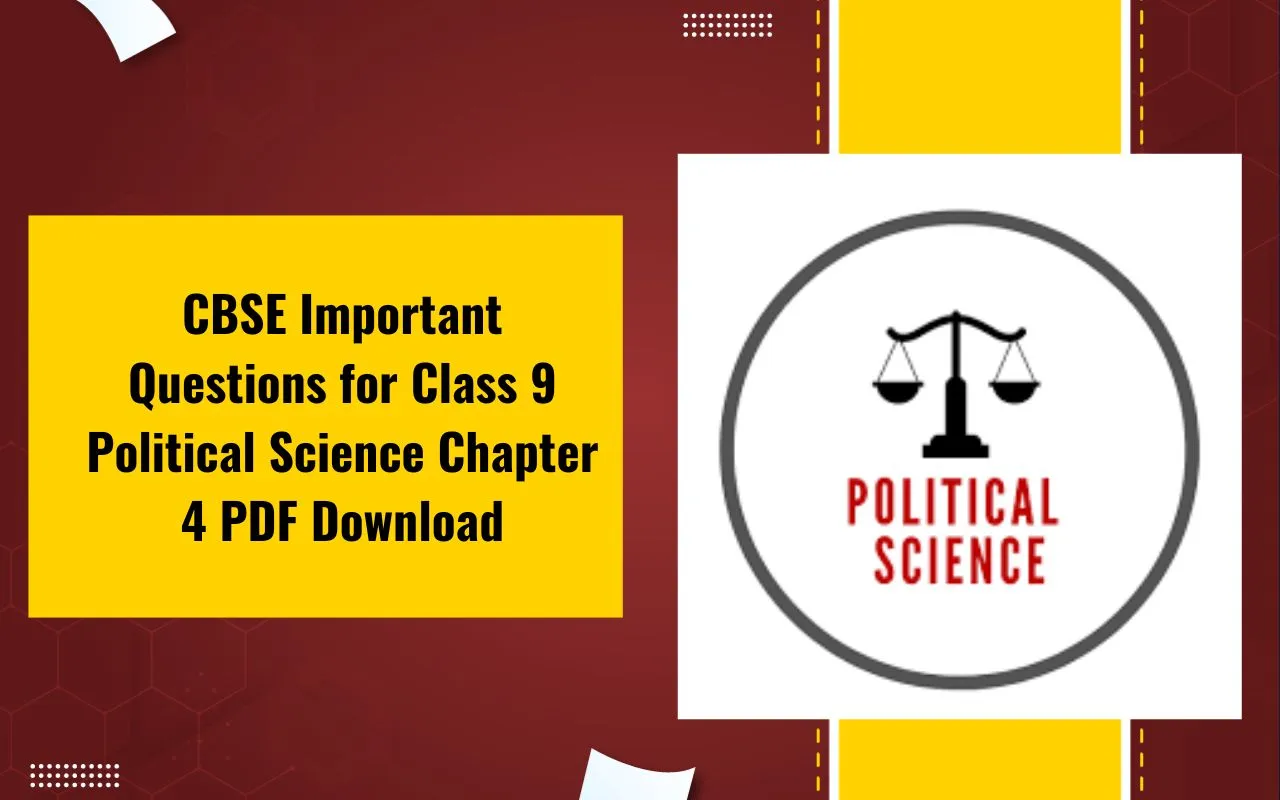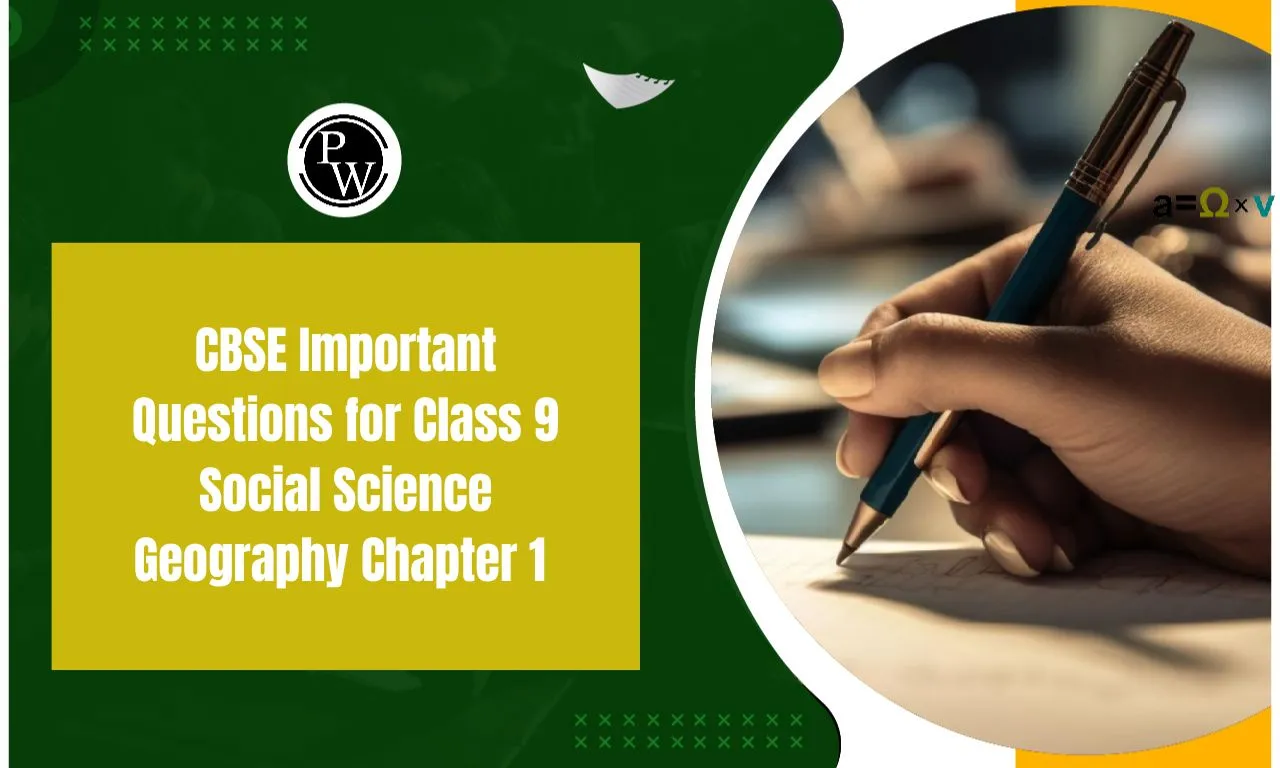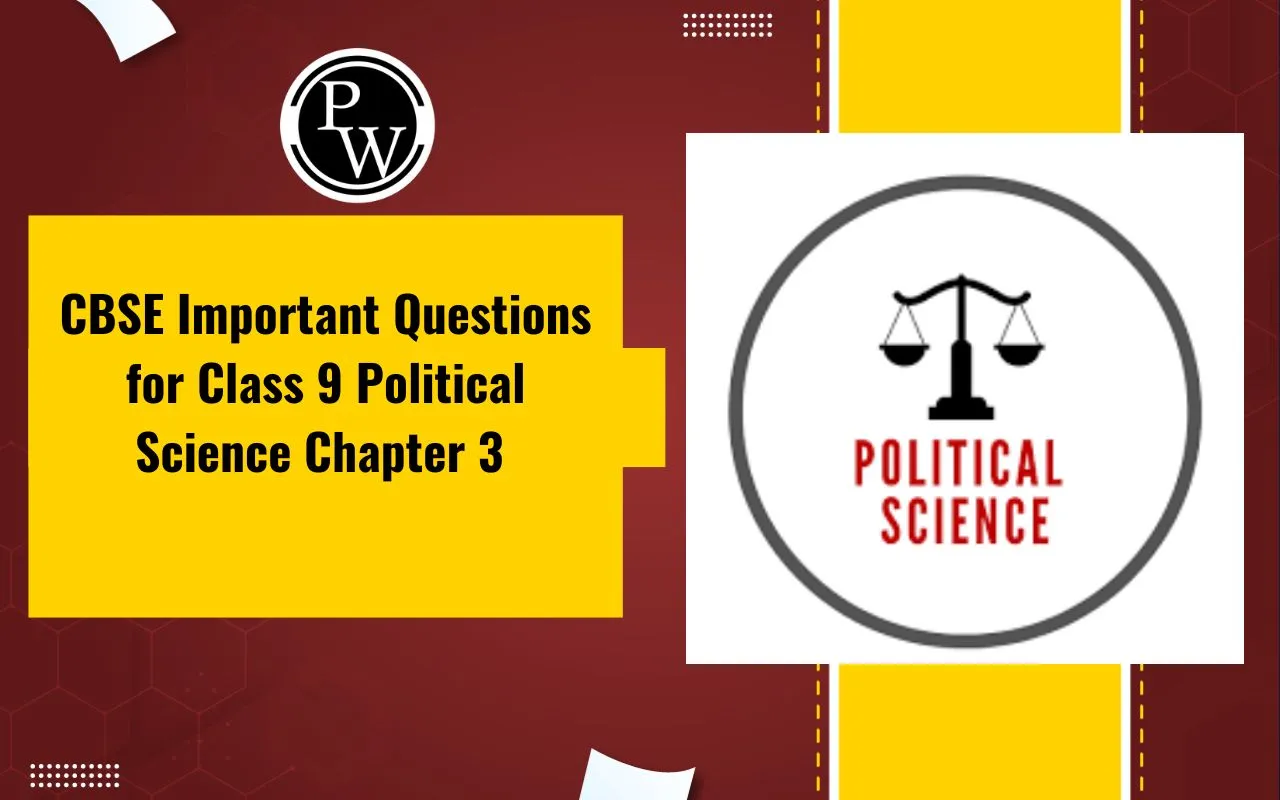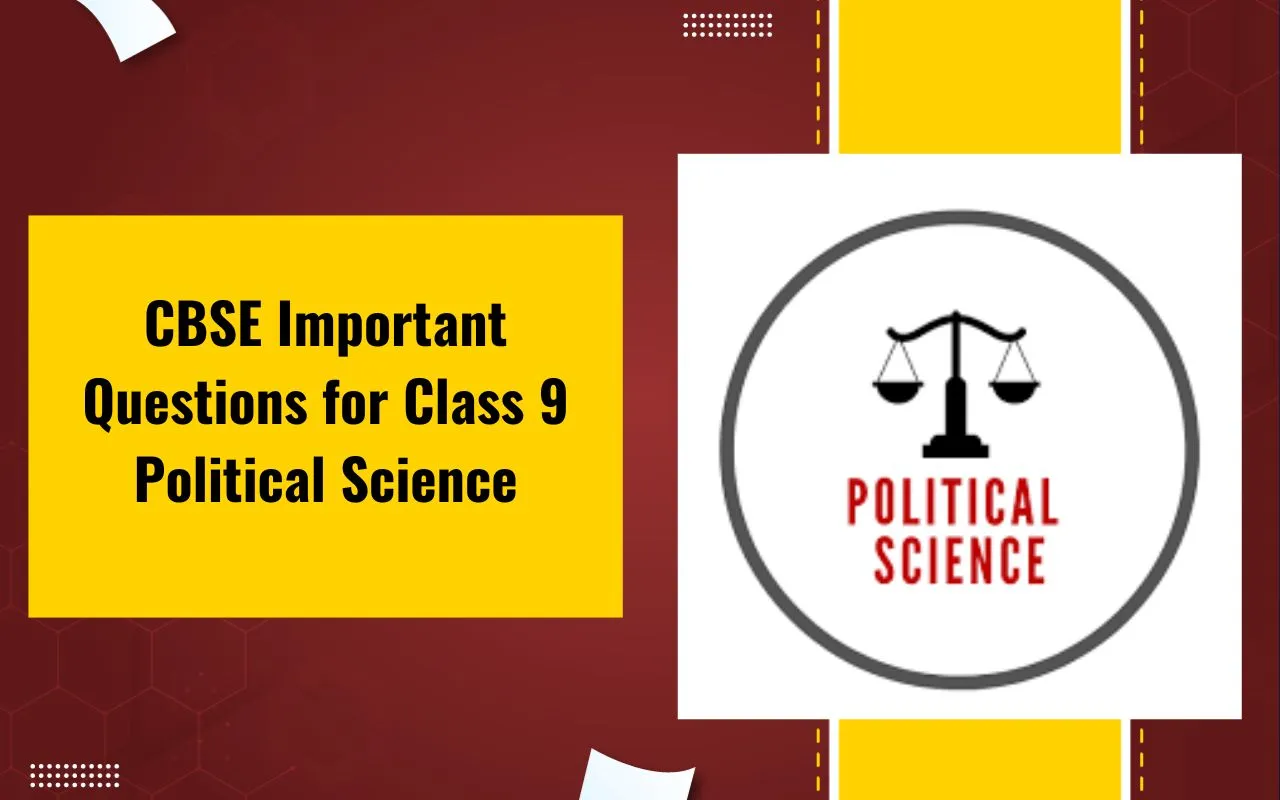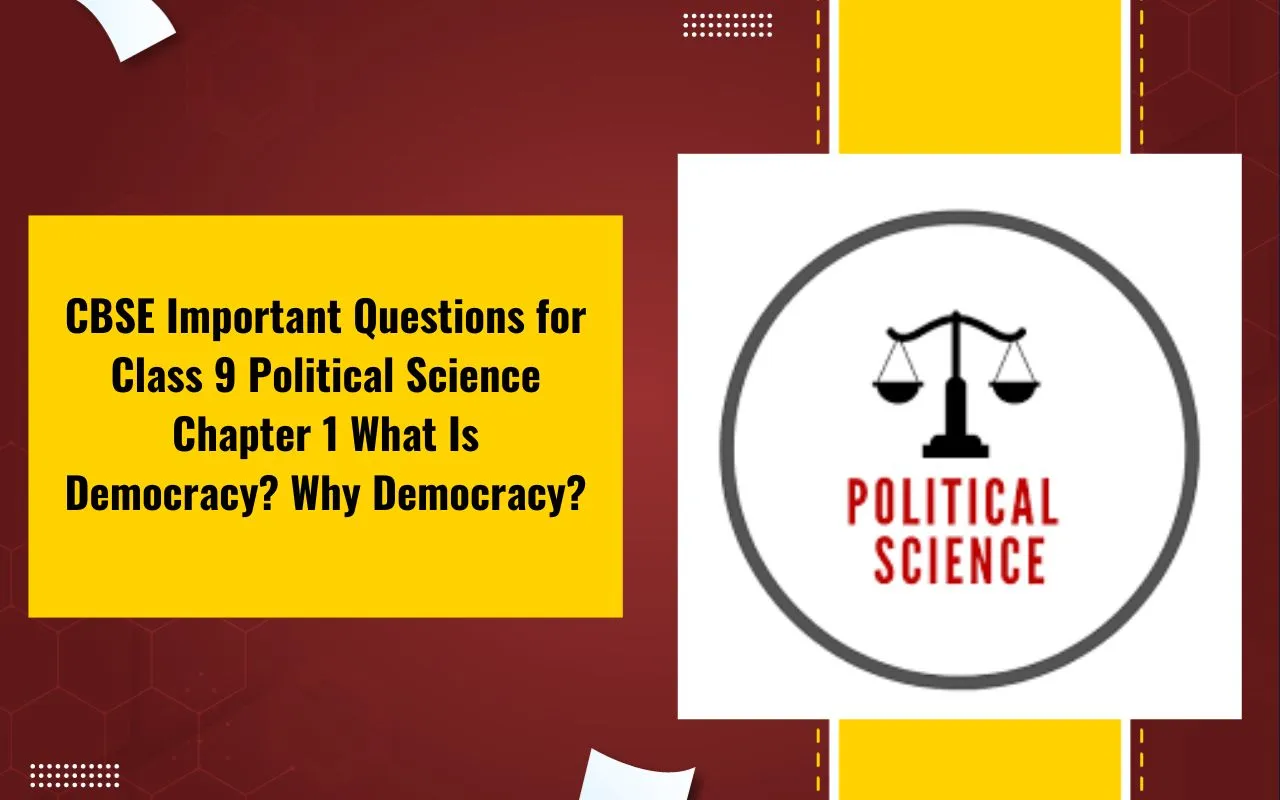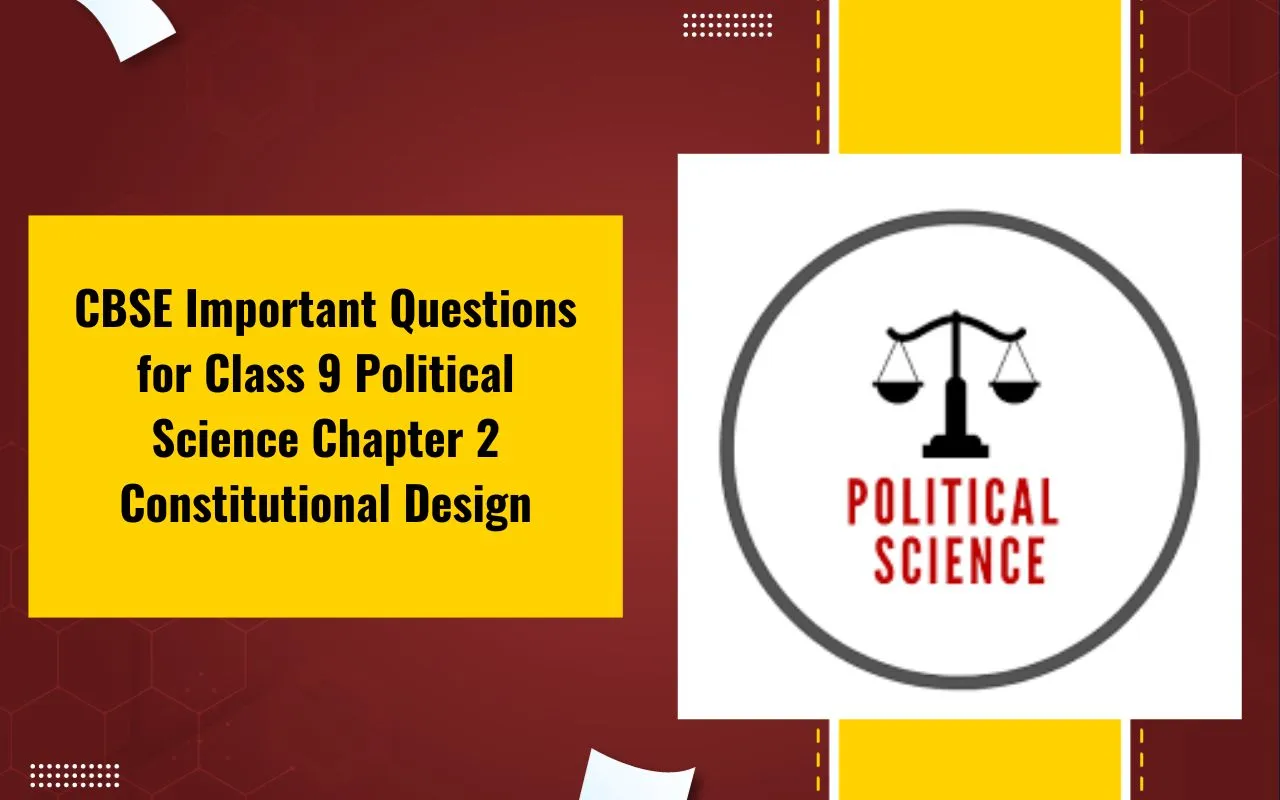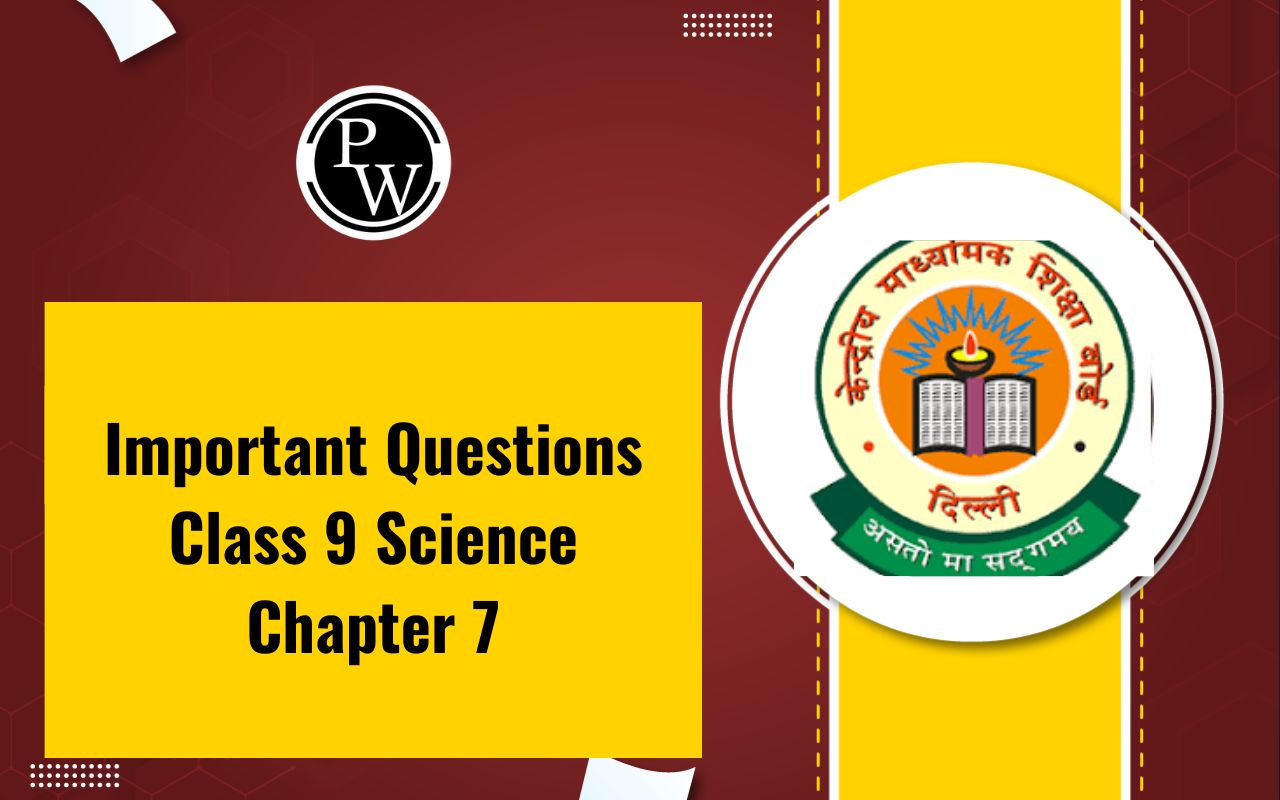
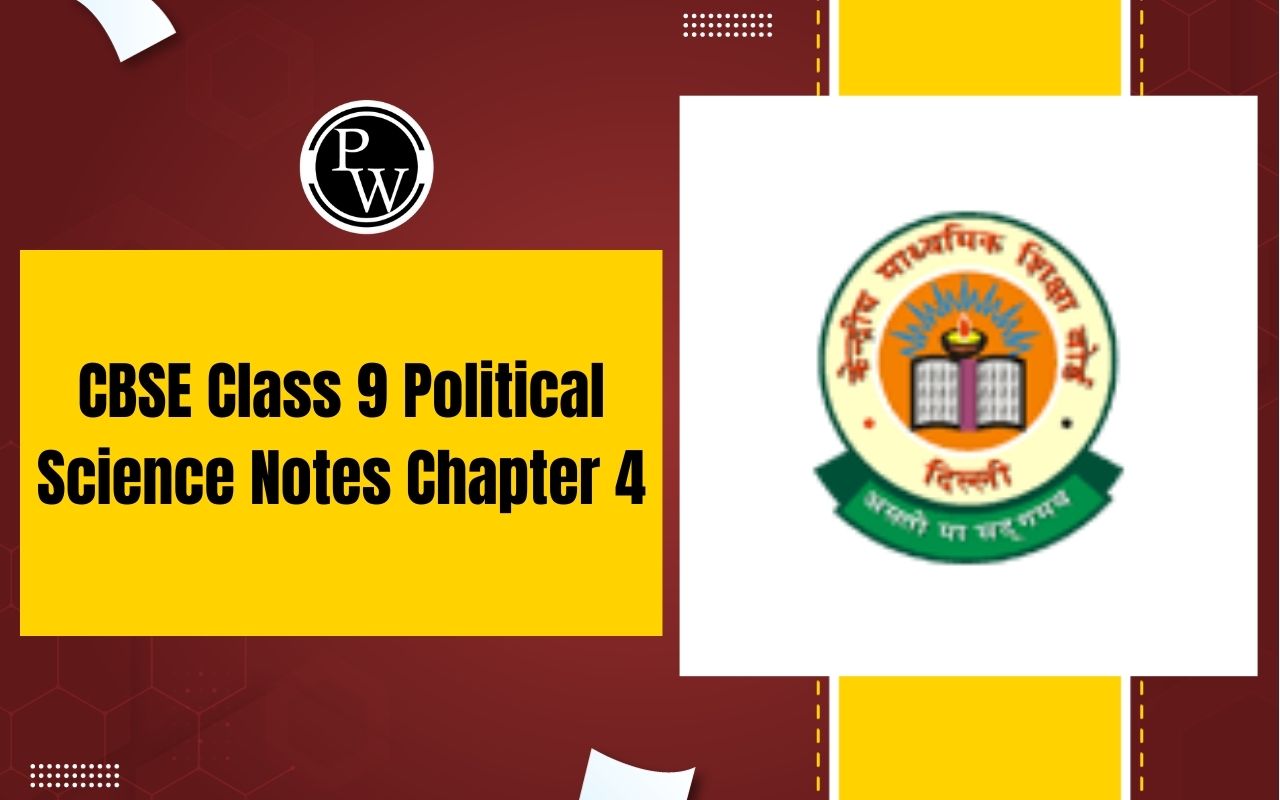
CBSE Class 9 Political Science Notes Chapter 4: Chapter 4 of CBSE Class 9 Political Science, "Working of Institutions," explores how important parts of government in India function.
It talks about the Executive, Legislature, and Judiciary, which are key to democracy. These institutions work together but also check each other's powers. They make decisions, pass laws, and ensure justice. Learning about how these institutions work helps students understand how our government operates and how decisions that affect everyone are made.CBSE Class 9 Political Science Notes Chapter 4 Overview
These notes, prepared by experts at Physics Wallah, give an overview of Chapter 4 in CBSE Class 9 Political Science. This chapter is called "Electoral Politics" and it talks about how elections work and why they are important in democracies. It covers topics like how elections are conducted, the role of political parties, and how voting shapes the government and its decisions.CBSE Class 9 Political Science Notes
The notes explain how elections let people choose their leaders and have a say in how their country is run. They also show how political parties help organize people's opinions and make sure leaders are accountable. These notes are meant to help students understand how elections and politics play a big role in democratic countries.CBSE Class 9 Political Science Notes Chapter 4 PDF
You can access the PDF link for CBSE Class 9 Political Science Notes Chapter 4 below. Whether you’re studying for exams or enhancing your understanding of Political Science, these notes are a valuable resource to grasp fundamental concepts effectively.CBSE Class 9 Political Science Notes Chapter 4 PDF
CBSE Notes Class 9 Political Science Chapter 4 – Working of Institutions
Here we have provided CBSE Notes Class 9 Political Science Chapter 4 for the ease of students so that they can prepare better for their exams.How Is a Major Policy Decision Taken?
A Government Order
When making major policy decisions, governments issue official orders or notifications. For instance, on August 13, 1990, the Government of India issued an Office Memorandum. This memorandum introduced a new policy regarding job reservations. It stated that, apart from the existing reservations for Scheduled Castes (SC) and Scheduled Tribes (ST), an additional 27% of job reservations would now be allocated to a newly recognized category known as Socially and Educationally Backward Classes (SEBC). This policy aimed to provide job opportunities specifically to individuals from backward classes. Such decisions are crucial as they determine how resources and opportunities are distributed among different sections of society, ensuring equitable access to employment and benefits.The Decision Makers
The decision to issue the Office Memorandum on job reservations in India involved several key decision-makers. The President of India, as the highest formal authority, holds a symbolic role in governance. The Prime Minister, who heads the government and leads Cabinet meetings, plays a crucial role in policy decisions. The Parliament, comprising the President and two Houses (Lok Sabha and Rajya Sabha), must support major decisions made by the Prime Minister. When the Office Memorandum was issued, it sparked heated debates across India. Critics argued it could lead to inequality by denying equal opportunities to those outside of backward communities. Supporters believed it would provide fair opportunities to historically underrepresented groups in government jobs. This debate culminated in the landmark 'Indira Sawhney and Others vs Union of India' case heard by the Supreme Court in 1992. The Supreme Court judges ultimately upheld the validity of the government's order, settling the dispute. Since then, this policy has been implemented to ensure job opportunities are distributed equitably among different sections of societyNeed for Political Institutions
In modern democracies, political institutions play a crucial role in ensuring effective governance. These institutions, such as meetings, committees, and established routines, are essential for democracy to function smoothly. Firstly, institutions ensure that decisions are not made hastily but are carefully considered through consultations involving a broader range of people. This inclusivity helps in representing diverse perspectives and interests within society. Secondly, although institutions may slow down the decision-making process, they also prevent rushed or poorly thought-out decisions from being implemented. This aspect of institutional functioning ensures that decisions undergo thorough scrutiny and evaluation, reducing the likelihood of mistakes or decisions that could harm the public interest. In essence, while political institutions may introduce complexities and procedural delays, their role is critical in upholding the principles of democracy by promoting transparency, accountability, and the consideration of diverse viewpoints in decision-making processes.Parliament
In parliamentary systems, decisions are not directly made within the Parliament itself. Instead, parliamentary discussions and debates on various issues, often based on reports or proposals, significantly influence and shape the government's decisions. These discussions exert pressure on the government to take action. If Parliament expresses strong opposition to a proposed decision, the government cannot proceed with implementing it. This mechanism ensures that decisions reflect the will of Parliament, which represents the interests and concerns of the public. Ultimately, the government's ability to implement decisions depends on gaining parliamentary support, highlighting the critical role of parliamentary debates in democratic governance.Why Do We Need the Parliament?
Parliament, or a legislative assembly at the state level, is essential in any democracy as it represents the supreme political authority on behalf of the people. Its importance can be understood through several key roles: Firstly, Parliament is responsible for making laws, making it the final authority in any country's legislative process. Secondly, decisions made by the government require the support of Parliament, ensuring that policies reflect the will of elected representatives. Parliament controls government finances, ensuring accountability and responsible spending of public funds.Two Houses of Parliament
In India, Parliament is divided into two houses:- The Council of States (Rajya Sabha): This house is not directly elected by the people but rather by members of state legislatures and appointed by the President. Its primary role is to represent the interests of states and federal units. The Rajya Sabha also has special powers over states as outlined in the Indian Constitution.
- The House of the People (Lok Sabha): This house is directly elected by the people of India and exercises significant power on behalf of the people. It plays a crucial role in making laws, especially in matters concerning ordinary legislation and money bills. The Lok Sabha also controls the Council of Ministers, holding them accountable for their actions.
Political Executive
In democratic governments, the executive branch is responsible for implementing government policies and decisions. This executive consists of two main categories:- Political Executive: This includes leaders elected by the people for a specific term. Ministers, who are part of the political executive, hold the authority to make significant decisions on behalf of the people. They are directly accountable to the public for the outcomes of their decisions. While ministers may not always be experts in every aspect of their ministries, they rely on expert advice to make informed decisions.
- Permanent Executive (Civil Services): These are individuals appointed on a long-term basis to carry out day-to-day administrative tasks. Civil servants, or bureaucrats, work under the political executive's direction to implement policies and manage governmental operations. They provide expertise and continuity in governance, regardless of changes in the ruling party.
Prime Minister and Council of Ministers
In parliamentary democracies like India, the Prime Minister is not directly elected by the people but is appointed by the President. The President appoints the leader of the majority party or coalition in the Lok Sabha as the Prime Minister. If no single party or coalition has a majority, the President appoints the person most likely to gain majority support. The Prime Minister's tenure is not fixed and depends on their ability to maintain majority support in the Lok Sabha. Once appointed, the Prime Minister advises the President on the appointment of other ministers, who are usually members of the majority party or coalition in the Lok Sabha. The Council of Ministers, comprising about 60 to 80 ministers, includes various ranks:- Cabinet Ministers: These are senior leaders responsible for major ministries and form the inner circle of the Council, with around 25 members.
- Ministers of State with independent charge: They oversee smaller ministries and participate in Cabinet meetings when invited.
- Ministers of State: Junior ministers who assist Cabinet Ministers and Ministers of State with independent charge.
Powers of the Prime Minister
As the head of the government in parliamentary democracies like India, the Prime Minister holds significant powers:- Chairing Cabinet Meetings: The Prime Minister presides over Cabinet meetings where major policy decisions are discussed and finalized.
- Coordination of Government Departments: He oversees and coordinates the activities of various government departments to ensure cohesive governance.
- Final Decision in Disputes: In case of disagreements between departments, the Prime Minister's decisions are decisive and binding.
- Supervision of Ministries: He exercises general supervision over different ministries to ensure they function effectively and in line with government policies.
- Appointment and Dismissal of Ministers: The Prime Minister has the authority to appoint ministers to their posts and can dismiss them if necessary.
- Collective Resignation: If the Prime Minister resigns from office, the entire ministry also resigns, leading to a change in government leadership.
The President
The President of India serves as the Head of the State and oversees the overall functioning of all political institutions to ensure they work together harmoniously to achieve the state's objectives.Election of President
The President is not directly elected by the people. Instead, a candidate standing for the President’s post needs to secure a majority of votes from Members of Parliament (MPs) and Members of Legislative Assemblies (MLAs) to win the election.Powers of President
- Symbolic Role: All governmental activities are conducted in the name of the President, symbolizing the authority of the state.
- Legislative Powers: All laws and major policy decisions of the government are issued in the name of the President.
- Appointments: The President appoints key officials such as the Chief Justice of India, Judges of the Supreme Court and High Courts, Governors of states, Election Commissioners, and Ambassadors to other countries.
- International Relations: The President represents India in international affairs and oversees the signing of treaties and agreements with other nations.
- Commander-in-Chief: The President serves as the supreme commander of India's defence forces.
The Judiciary
The judiciary in India comprises all courts at various levels:- Supreme Court: The highest court in the country, responsible for the entire nation.
- High Courts: Found in each state, these courts handle matters within their respective states.
- District Courts: Operate at the district level and handle cases within their districts.
- Local Courts: Handle cases at the local level, ensuring justice is accessible across communities.
Integrated Judiciary
India follows an integrated judiciary where the Supreme Court oversees judicial administration nationwide. Its decisions are binding on all other courts and it has jurisdiction over disputes:- Between citizens
- Between citizens and the government
- Between states
- Between the union and state governments
Independence of the Judiciary
Judicial independence means courts operate independently of the legislature and executive branches. Judges aren't influenced by the government or ruling party's directives.Appointment and Removal of Judges
Judges for the Supreme Court and High Courts are appointed by the President based on the Prime Minister's advice and the Chief Justice's consultation. Once appointed, a judge serves until retirement and can only be removed through impeachment by a two-thirds majority in Parliament.Powers of Judiciary
The judiciary in India holds significant authority, making it one of the most powerful in the world:- Interpretation of the Constitution: Both the Supreme Court and the High Courts can interpret the Constitution of India, ensuring laws align with its principles.
- Judicial Review: They have the power of judicial review, meaning they can assess the constitutionality of laws and actions taken by the executive branch. This ensures that governmental actions do not violate constitutional rights.
- Protection of Core Constitutional Principles: The Supreme Court has ruled that fundamental principles of the Constitution cannot be altered by Parliament, safeguarding its core values.
- Guardian of Fundamental Rights: The judiciary acts as a guardian of fundamental rights, ensuring that these rights are protected and enforced. Citizens can approach the courts through public interest litigation if government actions threaten public welfare.
Benefits of CBSE Class 9 Political Science Notes Chapter 4
- Structured Learning: Notes provide a structured overview of the chapter, organizing key concepts, definitions, and explanations in a concise manner.
- Clarity and Understanding: They help in clarifying complex topics and concepts, making it easier for students to grasp the content.
- Comprehensive Coverage: These Notes cover all essential aspects of the chapter, ensuring that students have a comprehensive understanding of the topics discussed.
- Time-Saving: They save time by providing a consolidated view of the chapter's content, reducing the need to go through extensive textbooks or other resources.
CBSE Class 9 Political Science Notes Chapter 4 FAQs
What are political institutions?
Political institutions are formal structures within a government or organization that define its functions, roles, and powers. They include legislative bodies, executive agencies, judiciary, and other entities that play crucial roles in governance.
Why are institutions important in a democracy?
Institutions in democracy ensure checks and balances, promote accountability, and safeguard the rule of law. They provide frameworks for decision-making, law-making, and implementation, ensuring stability and fairness in governance.
What is the role of Parliament in a democracy?
Parliament plays a important role in law-making, representing citizens' interests, overseeing the executive branch, and debating important national issues. It ensures that government actions are transparent, accountable, and in line with public interests.
How does the executive branch function in a democracy?
The executive branch, led by the Prime Minister or President, implements laws and policies formulated by the legislature. It includes ministers and civil servants who manage government departments and agencies, executing day-to-day governance tasks.
What is the judiciary's role in upholding democracy?
The judiciary interprets laws, resolves disputes, ensures constitutional validity, and protects individual rights and freedoms. It acts as a check on the legislative and executive branches, ensuring they operate within the confines of the law.
🔥 Trending Blogs
Talk to a counsellorHave doubts? Our support team will be happy to assist you!

Check out these Related Articles
Free Learning Resources
PW Books
Notes (Class 10-12)
PW Study Materials
Notes (Class 6-9)
Ncert Solutions
Govt Exams
Class 6th to 12th Online Courses
Govt Job Exams Courses
UPSC Coaching
Defence Exam Coaching
Gate Exam Coaching
Other Exams
Know about Physics Wallah
Physics Wallah is an Indian edtech platform that provides accessible & comprehensive learning experiences to students from Class 6th to postgraduate level. We also provide extensive NCERT solutions, sample paper, NEET, JEE Mains, BITSAT previous year papers & more such resources to students. Physics Wallah also caters to over 3.5 million registered students and over 78 lakh+ Youtube subscribers with 4.8 rating on its app.
We Stand Out because
We provide students with intensive courses with India’s qualified & experienced faculties & mentors. PW strives to make the learning experience comprehensive and accessible for students of all sections of society. We believe in empowering every single student who couldn't dream of a good career in engineering and medical field earlier.
Our Key Focus Areas
Physics Wallah's main focus is to make the learning experience as economical as possible for all students. With our affordable courses like Lakshya, Udaan and Arjuna and many others, we have been able to provide a platform for lakhs of aspirants. From providing Chemistry, Maths, Physics formula to giving e-books of eminent authors like RD Sharma, RS Aggarwal and Lakhmir Singh, PW focuses on every single student's need for preparation.
What Makes Us Different
Physics Wallah strives to develop a comprehensive pedagogical structure for students, where they get a state-of-the-art learning experience with study material and resources. Apart from catering students preparing for JEE Mains and NEET, PW also provides study material for each state board like Uttar Pradesh, Bihar, and others
Copyright © 2025 Physicswallah Limited All rights reserved.
Get App
